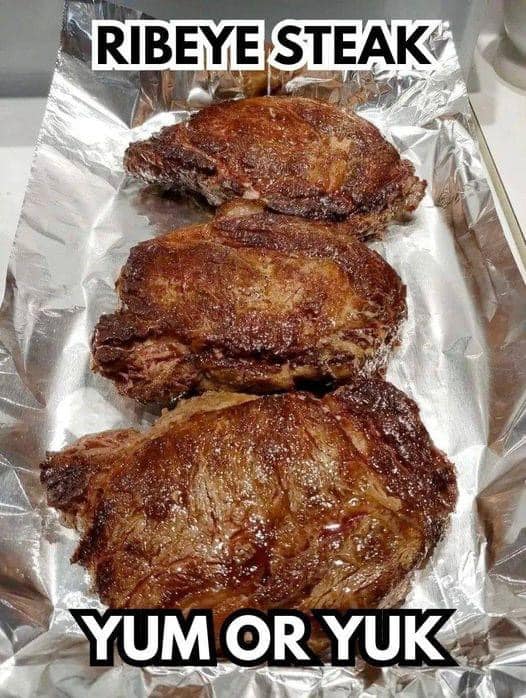Introduction
Cooking a ribeye steak to perfection is a blend of art and science. Known for its rich marbling and intense flavor, ribeye is a top choice for steak lovers worldwide. Let’s dive into every detail of making this mouth-watering steak at home.
Origin and History of Ribeye Steak
The ribeye cut comes from the rib section of the cow and has been a staple in American and European cuisine. This tender, flavorful cut became a popular choice among butchers and chefs alike for its marbled fat content, which enhances its flavor and tenderness.
Cultural Significance of Steak
Steak dinners hold a special place in many cultures, often reserved for celebrations or hearty meals that bring people together. From classic American steakhouses to European fine dining, ribeye steak is a beloved dish symbolizing indulgence and satisfaction.
Ingredients for the Perfect Ribeye
To make a truly outstanding ribeye, you need quality ingredients:
- 1 ribeye steak
- Sea salt flakes
- Freshly ground black pepper
- 50g butter
- 2 sprigs of thyme
- 1 garlic clove, crushed with its skin
Essential Ingredient Quantities
- Ribeye Steak: Ensure it’s about 3 cm thick for an even cook.
- Butter: Adds richness; use unsalted butter to control the salt levels.
- Herbs and Garlic: Thyme and garlic elevate the flavor and aroma, especially when used during basting.
Optional Additions for Extra Flavor
For additional flavor, consider adding a splash of Worcestershire sauce, fresh rosemary sprigs, or even a sprinkle of smoked paprika. These additions can add complexity to your steak without overpowering its natural flavors.
Tips for Success
Bringing the Steak to Room Temperature
Take the steak out of the fridge 30 minutes before cooking. This step allows the meat to cook evenly, ensuring that the inside is tender and juicy.
Seasoning Tips
Be generous with the sea salt and freshly ground black pepper. These two ingredients help enhance the steak’s natural flavors, giving it that classic steakhouse taste.
Choosing the Right Pan
A heavy-duty cast-iron skillet or a stainless-steel pan works best. These retain heat well, providing the high temperatures necessary to achieve a good sear.
Step-by-Step Instructions
Preparing the Steak
Remove the steak from the refrigerator and allow it to sit at room temperature for about 30 minutes.
Seasoning Generously
Sprinkle sea salt and freshly ground black pepper on both sides of the steak. Ensure an even coating to enhance flavor.
Heating the Pan
Preheat a frying pan over medium-high heat. If you’re cooking multiple steaks, consider using a large enough pan or cooking them separately.
Cooking the Steak
Place the steak in the hot pan, cooking for 2-3 minutes on each side. Adjust the time based on thickness and doneness preference. For medium-rare, aim for about 5 minutes total for a 3 cm thick steak. Use a meat thermometer if available: 50°C for rare, 60°C for medium, and 70°C for well-done.
Adding Flavor with Butter and Herbs
After flipping the steak, add butter, thyme, and garlic to the pan. As the butter melts, tilt the pan slightly and use a spoon to baste the steak. This step adds incredible flavor and juiciness.
Resting the Steak
Remove the steak from the pan and let it rest for 5 minutes. Resting helps the juices redistribute within the meat, making each bite tender and flavorful.
Slicing and Serving
Slice the steak into thin strips, season as needed, and serve with your favorite sides and sauces.
Detailed Description of Cooking Process
Cooking a ribeye involves carefully balancing temperature and time. The high heat sears the outside, creating a golden-brown crust while preserving the tenderness within. Basting with butter and herbs introduces depth, making each bite unforgettable.
Nutritional Information for Ribeye Steak
A standard ribeye steak (about 200g) contains approximately:
- Calories: 500 kcal
- Protein: 36g
- Fat: 40g
- Iron: 2.6 mg
- Potassium: 540 mg
Health Benefits of Enjoying Steak in Moderation
Steak is rich in protein, iron, and essential nutrients. Consuming it in moderation can support muscle health, iron levels, and overall energy. However, pairing it with vegetables and balancing it in your diet is key to a healthy lifestyle.
Why Quality Matters: Selecting the Right Cut
Choosing a high-quality ribeye ensures a tender and flavorful steak. Look for well-marbled pieces with a bright red color. Prime or choice cuts tend to be the most flavorful.
The Art of Basting for Juiciness
Basting is the process of spooning melted butter over the steak while it cooks. This adds moisture, flavor, and a luxurious mouthfeel. The thyme and garlic infuse into the butter, creating an aromatic experience.
Common Mistakes to Avoid When Cooking Ribeye
- Skipping the Rest Period: Cutting into the steak right away releases the juices.
- Underseasoning: Don’t be shy with the salt and pepper.
- Using Low Heat: High heat is essential for that perfect crust.
Conclusion
Cooking the perfect ribeye steak at home is entirely achievable with the right technique. With quality ingredients, the right pan, and attention to detail, you can create a restaurant-worthy steak every time. Enjoy the process and, most importantly, savor every bite!
Frequently Asked Questions
- How long should I rest the steak?
Rest the steak for at least 5 minutes to lock in the juices. - What’s the best pan for cooking ribeye?
A cast-iron skillet is ideal because it retains high heat. - Can I use salted butter for basting?
Yes, but adjust the seasoning to avoid over-salting. - What’s the difference between ribeye and sirloin?
Ribeye has more marbling, making it juicier and more flavorful than sirloin. - Should I marinate the ribeye?
Marinating isn’t necessary, as ribeye has plenty of natural flavor.
